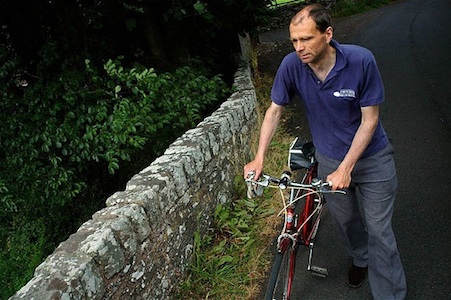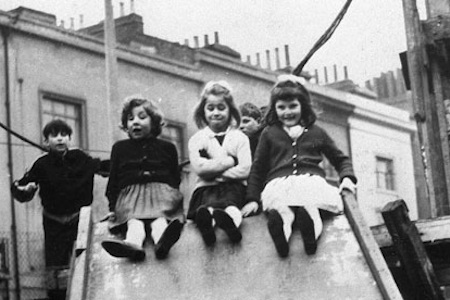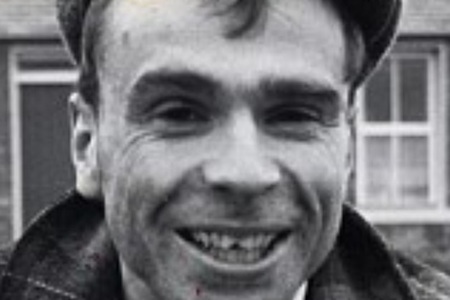This “special edition” of The Big Ones represents a bit of a cheat on the column’s essential premise in a couple of ways. For one thing, Michael Apted’s ongoing series of “Up” documentaries, one of which has been produced every seven years since 1964, can only be considered to be a single long filmwork by making a specific act of interpretation. Its/their existence as one long film is somewhat belied by the very nature of the film(s), whereby a new installment can only emerge once every seven years. It would be more proper, then, to call the “Ups” a project rather than a film per se.
Second, the documentary originated on television—first on the now-defunct Northwest English network Granada Television, and currently on ITV (which was formed out of Granada and other regional channels). In the States and elsewhere, Apted’s series has been edited to form individual feature films for commercial release since 21 Up in 1977. So again, treating the works as a large documentary masterwork of nearly 16 hours is a bit misleading, in the same since that Season 3 of The Sopranos would not qualify as a “Big One.”
All the same, I’ve chosen to address the Apted films, on the occasion of the theatrical release of 56 Up, for a few reasons. First, one of the considerations of this column has always been the unique circumstances that contemporary media—home video in particular—create for the consumption and comprehension of very long cinematic works. While it is true that many older film critics, along with academics specializing in documentary film, have been taking the “Ups” in quite faithfully every seven years, regarding the release of each new installment as a significant and predictable event, for many of us there is little choice but to play catch-up with these 56 years’ worth of filmmaking.
This means binge viewing, which indeed is much more of a piece with how we are accustomed nowadays to taking in a TV series (e.g., “finally watching The Wire”) than sitting even with the longest films. With the exception of a few key films that originated as TV series, like Berlin Alexanderplatz or the various Heimat series, most similarly paced and elongated works tend to be classics of nonfiction. Perhaps of necessity, works such as Lanzmann’s Shoah, Wiseman’s Public Housing, Watkins’ The Journey, or numerous Ken Burns efforts, which are undoubtedly individual films, are broken into parts or chapters, which then become the equivalent of episodes when broadcast or viewed in the home. So in this respect, the present-day totality of Apted’s “Ups,” as they currently exist, provide a not-dissimilar totality, a radical compression of time and history even as displayed across a running time which, by conventional standards, is expanded and indeed challenging.
The other major consideration with Apted’s films, in terms of thinking of the “Up” project as a “whole thing,” is the monumentality that the work has accrued over the years. Part of this is due to the bracing originality of the “Up” premise. Based (as each and every installment will remind you—more on that in a second) on the Jesuit proverb attributed to Francis Xavier, “Give me the child until he is seven, and I will give you the man,” the original Seven Up program (co-produced by Apted and Paul Almond) represented a unique intersection between TV human-interest news programming, micro-sociology (in the sense of examining the structure of small groups) and auto-ethnography, a practice that was so new in 1964 that it had not been conceptualized quite yet. Ethnography typically meant looking at “Other” cultures. For Great Britain to look, anthropologically, at itself was really rather novel.
So as this effort has continued, tracking the life stories of those participants who we first got to see as hopeful (or in some cases fearful) seven-year-old boys and girls, the “Up” films have attained a singular status in documentary if not film history. After all, from Griffith and Eisenstein onward, the very fundamentals of cinema have oriented us towards temporal simultaneity across space. (E.g., the galloping horse and the victim tied to the railroad track, at the same time, joined by a splice.) Most documentaries expand on this basic grammar, allowing us to compare current conditions in different corners of the globe. The “Up” project is virtually in a class by itself, given that it has provided a longitudinal cinematic study.
As such, it not only offers a core sample of individual lives across time, with all that entails (aging, shifting cultural attitudes, effects of free will against the vicissitudes of social structure). It also registers the ongoing movement of documentary film itself: its forms and procedures, its shibboleths and mores. One of the things that one notices immediately by watching the “Ups” straight through, from 7 to 56, is the evolution of the films from a stuffy, echt-British news format, with a “special bulletin” horn-blast theme and starchy rigidity that borders on parody (the Monty Python boys definitely learned from these films), to a more relaxed, chat show approach in the 35 and 42 range. By 49, the participants themselves cannot resist commenting on how they themselves were pioneers of reality TV, and by 56, Apted has adopted a chummy tone and a soft-focus photography that is pure Oprah.
The editing patterns evolve over time as well. Since Apted is rightly presuming a viewer who has not seen the previous episode or episodes for at least seven years, each participant is introduced with a selection of clips from the previous series entries. These are not, however, mere intros or “Previously on Up” montages. Apted uses the earlier clips to emphasize irony and change, such as when the moody Suzy condemns the series at 14, says at 21 that she’ll never marry or have children, and then is shown from 28 onward in a stable marriage with kids. Likewise, when Symon is shown as a child forlornly describing having no father, and then beaming at 28 that he has five children and is giving them what he never had, Apted uses these clips for pathos when, later, his first marriage has failed and he admits he seldom sees his children from that relationship. The tone, however, isn’t intended to criticize or undercut Symon so much as to ironize any pretentions that any of us would feel secure in knowing what our own future holds.
But I would submit that watching all of the installments back to back also reveals the extent to which Apted manipulates the footage, especially in the editing, in ways that are designed to be invisible to the casual viewer. Clearly, if Apted kept the same amount of clips from each show, adding on without subtracting, each subsequent installment would be gargantuan. As it is, Apted’s devotion to format already insures that some classic clips will appear with the regularity of the Ed Ames tomahawk chop. We know, 7-year-old Lynn wanted to work at Woolworth’s. Paul didn’t want to get married because his wife might serve him greens. Bruce wanted to help people who were not “civilized” to “be good.” (But interestingly, as Apted’s fondness for the adult Suzy increases, we stop seeing her as a child saying she hopes to never meet any “colored people.”)
If anything dominates the form and approach to the “Up” films, it’s certainly Apted’s liberal politics, which he never attempts to disguise but at the same time never explicitly cops to. If there is one significant failing of the project, it’s that Apted, by being a television and film figure who is really neither committed to infotainment nor to academic rigor, has produced an object that is singular in its vulnerability to critique from either side. The films maintain a self-importance, which is by no means unearned. The final effect of diving deeply into the “Up” films is not only a sense of familiarity with interesting people from many walks of life, but the important impression that the Jesuit thesis that instigated the endeavor is merely the fulcrum of a dialectic. No one changes absolutely; but there is always more to everyone than meets the eye. (Apted, for instance, does his level best throughout the series to make John, the Thatcherite solicitor, look like an upper-class twit. But in 56 we see him and his wife engaged in charity work in Bulgaria. He’s still a Tory, but one who firmly believes in noblesse oblige.)
But the shape of the programs also seems to morph over time, and this could possibly have to do with Apted’s less than transparent ideas about what it means for him to put his class politics across in the muddled atmosphere of Lib-Con Britain. From 21 through 49, Neil was a particular object of fascination for these films. Often homeless, probably manic depressive, occasionally suicidal, Neil’s interviews showed him to be a deeply intelligent but miserable man, clearly in pain with no way to stop it. With the help of his friend and co-“Up” subject Bruce, he got on his feet and became a local elected official. This was a gripping narrative arc that Apted continually placed front and center in the project, until 56, when suddenly Neil is brought on early, to gripe randomly and then disappear. Could this be because, as a Liberal Democrat politician, Neil is no longer an exotic creature to Apted? (For the record, Neil says nothing about his party’s coalition with the Tories. John, however, remarks on it favorably.) Instead, Apted concludes with rowdy East Ender Tony the cab driver, who shows us that the empty lot that used to be the dog track, where he once ran numbers when he was a boy, is now the site of the Olympic Stadium.
Cool Britannia, right? See you in 2019!






